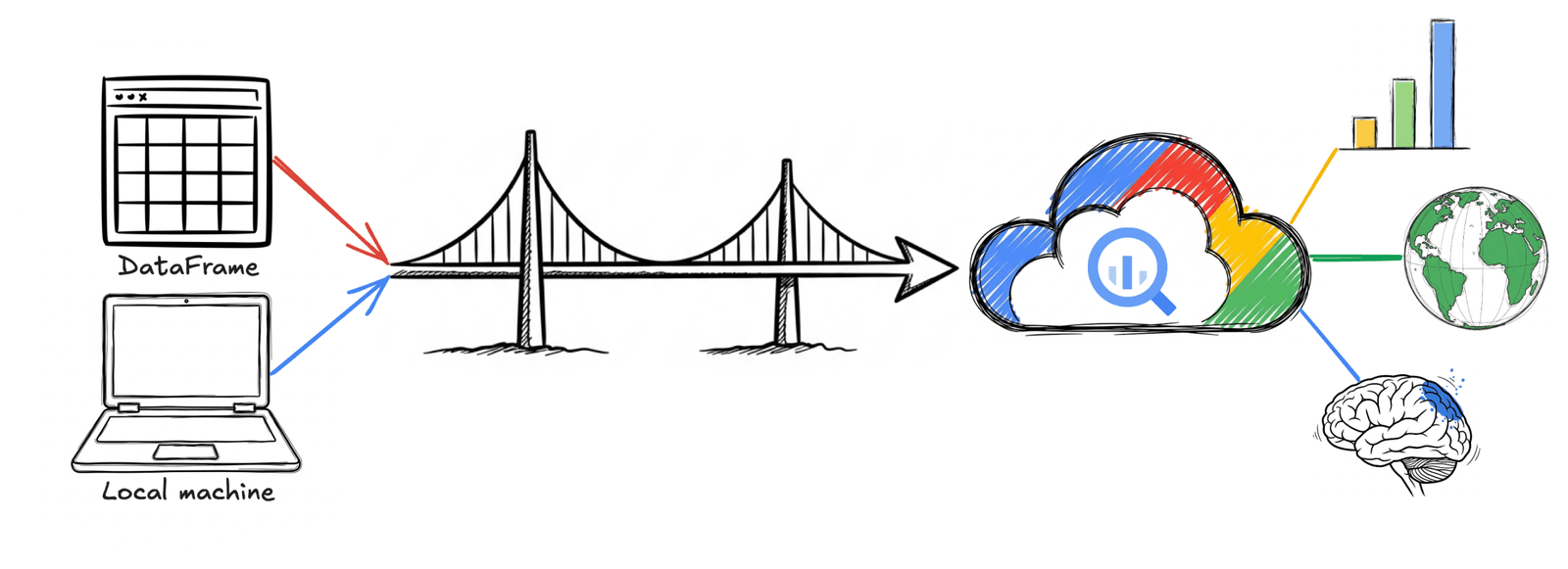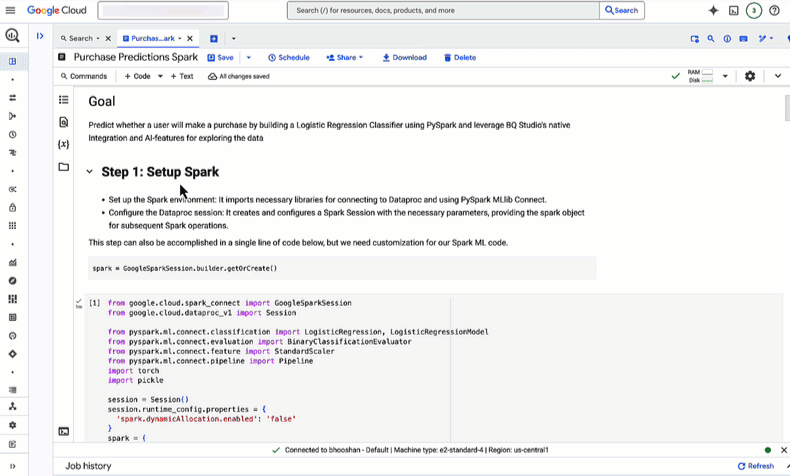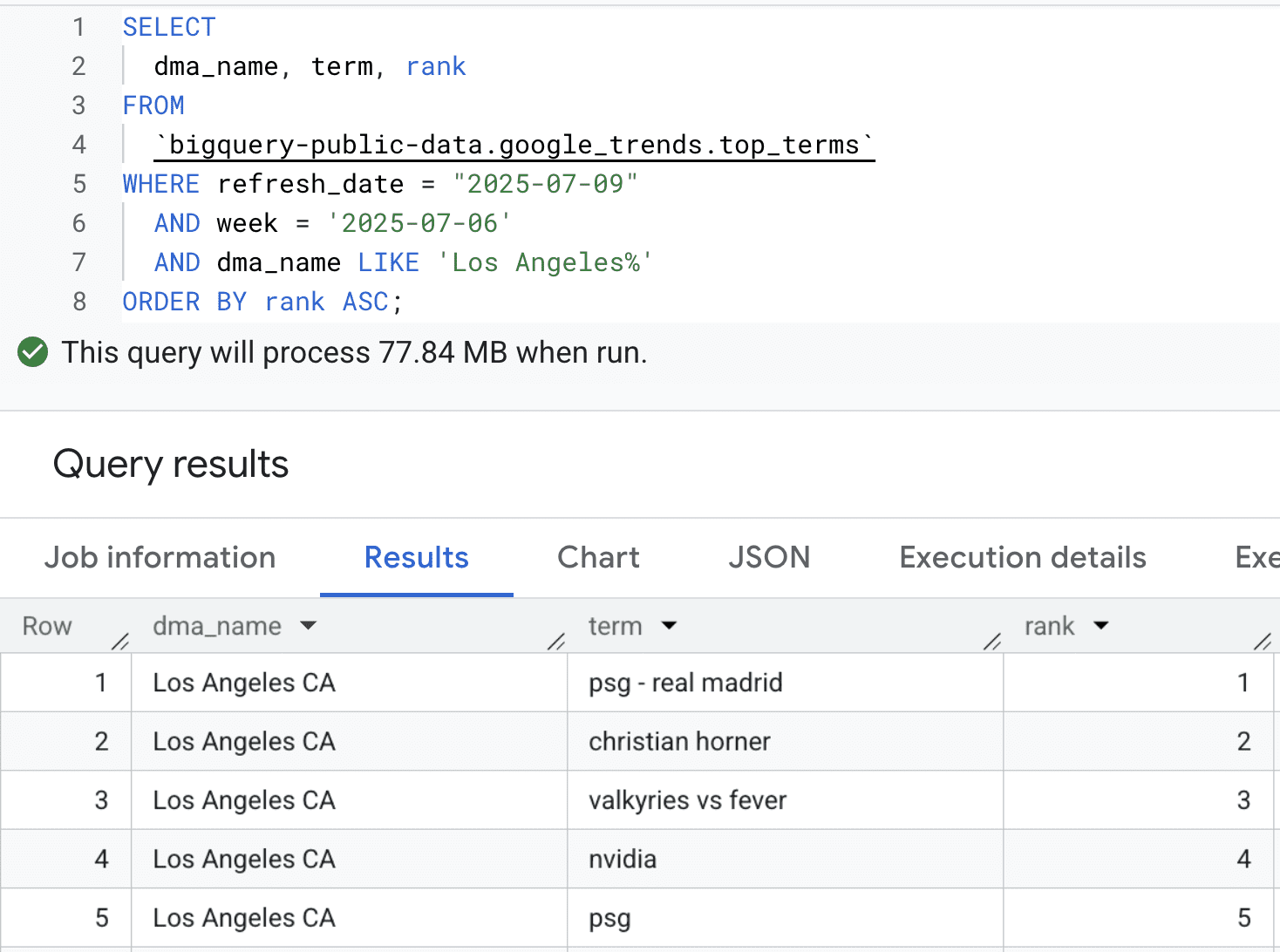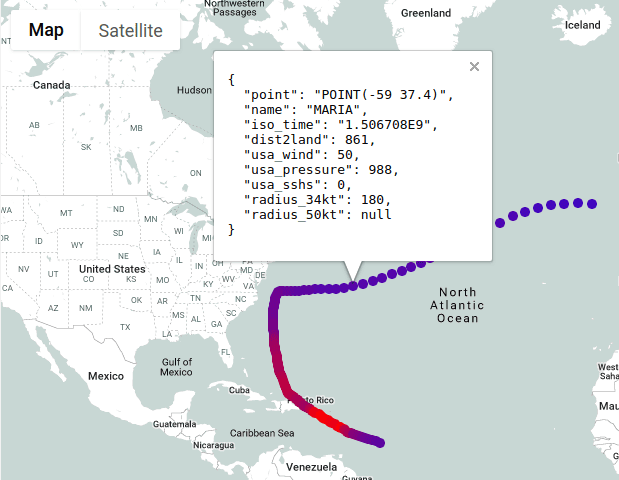AI in Travel
8 Ways to Scale your Data Science Workloads
Sponsored Content


How much time do you spend fighting your tools instead of solving problems? Every data scientist has been there: downsampling a dataset because it won’t fit into memory or hacking together a way to let a business user interact with a machine learning model.
The ideal environment gets out of the way so you can focus on the analysis. This article covers eight practical methods in BigQuery designed to do exactly that, from using AI-powered agents to serving ML models straight from a spreadsheet.
1. Machine Learning in your Spreadsheets


BQML training and prediction from a Google Sheet
Many data conversations start and end in a spreadsheet. They’re familiar, easy to use, and great for collaboration. But what happens when your data is too big for a spreadsheet, or when you want to run a prediction without writing a bunch of code? Connected Sheets helps by letting you analyze billions of rows of BigQuery data from the Google Sheets interface. All calculations, charts, and pivot tables are powered by BigQuery behind the scenes.
Taking it a step further, you can also access models you’ve built with BigQuery Machine Learning (BQML). Imagine you have a BQML model that predicts housing prices. With Connected Sheets, a business user could open a Sheet, enter data for a new property (square footage, number of bedrooms, location), and a formula can call a BQML model to return a price estimate. No Python or API wrangling needed – just a Sheets formula calling a model. It’s a powerful way to expose machine learning to non-technical teams.
2. No Cost BigQuery Sandbox and Colab Notebooks
Getting started with enterprise data warehouses often involves friction, like setting up a billing account. The BigQuery Sandbox removes that barrier, letting you query up to 1 terabyte of data per month. No credit card required. It’s a great, no-cost way to start learning and experimenting with large-scale analytics.
As a data scientist, you can access your BigQuery Sandbox from a Colab notebook. With just a few lines of authentication code, you can run SQL queries right from a notebook and pull the results into a Python DataFrame for analysis. That same notebook environment can even act as an AI partner to help plan your analysis and write code.
3. Your AI-Powered Partner in Colab Notebooks


Data Science Agent in a Colab Notebook (sequences shortened, results for illustrative purposes)
Colab notebooks are now an AI-first experience designed to speed up your workflow. You can generate code from natural language, get automatic error explanations, and chat with an assistant right alongside your code.
Colab notebooks also have a built-in Data Science Agent. Think of it as an ML expert you can collaborate with. Start with a dataset – like a local CSV or a BigQuery table – and a high level goal, like “build a model to predict customer churn”. The agent creates a plan with suggested steps (e.g. data cleaning, feature engineering, model training) and writes the code.
And you are always in control. The agent generates code directly in notebook cells, but doesn’t run anything on its own. You can review and edit each cell before deciding what to execute, or even ask the agent to rethink its approach and try different techniques.
4. Scale your Pandas Workflows with BigQuery DataFrames
Many data scientists live in notebooks and use pandas DataFrames for data manipulation. But there’s a well-known limit: all the data you process needs to fit into your machine’s memory. MemoryError exceptions are all too common, forcing you to downsample your data early on.
This is the exact problem BigQuery DataFrames solves. It provides a Python API intentionally similar to pandas. Instead of running locally, it translates your commands into SQL and executes them on the BigQuery engine. Meaning you can work with terabyte-scale datasets from your notebook, with a familiar API, and no worries about memory constraints. The same concept applies to model training, with a scikit-learn-like API that pushes model training to BigQuery ML.
5. Spark ML in BigQuery Studio Notebooks


Sample Spark ML notebook in BigQuery Studio
Apache Spark is a useful tool from feature engineering to model training, but managing the infrastructure has always been a challenge. Serverless for Apache Spark lets you run Spark code, including jobs using libraries like XGBoost, PyTorch, and Transformers, without having to provision a cluster. You can develop interactively from a notebook directly within BigQuery, letting you focus on model development, while BigQuery handles the infrastructure.
You can use Serverless Spark to operate on the same data (and the same governance model) in your BigQuery warehouse.
6. Add External Context with Public Datasets


Top 5 trending terms in the Los Angeles Area in early July 2025
Your first-party data tells you what happened, but can’t always explain why. To find that context, you can join your data with a large collection of public datasets available in BigQuery.
Imagine you’re a data scientist for a retail brand. You see a spike in sales for a raincoat in the Pacific Northwest. Was it your recent marketing campaign, or something else? By joining your sales data with the Google Trends dataset in BigQuery, you can quickly see if search queries for “waterproof jacket” also surged in the same region and period.
Or let’s say you’re planning a new store. You can use the Places Insights dataset to analyze traffic patterns and business density in potential neighborhoods, layering it on top of your customer information to choose the best location. These public datasets let you build richer models that account for real-world factors.
7. Geospatial Analytics at Scale


BigQuery Geo Viz map of a hurricane, using color to indicate radius and wind speed
Building location-aware features for a model can be complex, but BigQuery simplifies this by supporting a GEOGRAPHY data type and standard GIS functions within SQL. This lets you engineer spatial features right at the source. For example, if you are building a model to predict real estate prices, you could use a function like ST_DWithin to calculate the number of public transit stops within a one mile radius for each property. You can then use that value directly as input to your model.
You can take this further with Google Earth Engine integration, which brings petabytes of satellite imagery and environmental data into BigQuery. For that same real estate model, you could query Earth Engine’s data to add features like historical flood risk or even density of tree cover. This helps you build much richer models by augmenting your business data with planet-scale environmental information.
8. Make Sense of Log Data
Most people think of BigQuery for analytical data, but it’s also a powerful destination for operational data. You can route all of your Cloud Logging data to BigQuery, turning unstructured text logs into queryable resources. This allows you to run SQL across logs from all your services to diagnose issues, track performance, or analyze security events.
For a data scientist, this Cloud Logging data is a rich source to build predictions from. Imagine investigating a drop in user activity. After identifying an error message in the logs, you can use BigQuery Vector Search to find semantically similar logs, even if they don’t contain the exact same text. This could help reveal related issues, like “user token invalid” and “authentication failed”, that are part of the same root cause. You could then use this labeled data to train an anomaly detection model that flags patterns proactively.
Conclusion
Hopefully, these examples spark some new ideas for your next project. From scaling pandas DataFrames to feature engineering with geography data, the goal is to help you work at scale with familiar tools.
Ready to give one a shot? You can start exploring at no cost today in the BigQuery Sandbox!
Author: Jeff Nelson, Developer Relations Engineer
AI in Travel
When AI Deepfakes Send Tourists Chasing Illusions – Open Jaw
AI in Travel
How many Aussies are using AI to plan travel, who’s utilising it & what exactly are they using it for?

Nearly a third of Aussies are now using artificial intelligence (AI) to help plan their holidays, according to new research from Compare the Market.
In a survey of over 1,000 Australian adults, three in ten (28.8%) respondents said they relied on AI tools to lock in travel deals, scout destinations and find activities.
More than one in ten (11.5%) are specifically using AI for destination recommendations – the most popular use of AI in travel – while a similar number (10.3%) are seeking out deals.
Meanwhile, nearly one in ten (9.4%) look for recreational activities and accommodation, while one in 11 (9%) use AI to create itineraries, and nearly the same number (8.2%) search for flights and transport. A small percentage (3.2%) use AI to understand currency conversion.
“Australians love a good holiday and have never been afraid to ask for help when planning the perfect getaway,” Compare the Market’s Chris Ford says.
“Our latest data highlights a shift in the way travellers are approaching their planning, with convenience, personalisation and speed driving the adoption of innovative AI tools.”
When it comes to who’s using the technology, the survey reveals a clear generational divide.
The study found that, unsurprisingly, Gen Z and Millennials are the most likely to engage with AI when planning a trip.
On the other hand, the vast majority (93%) of Baby Boomers and three-quarters (76%) of Gen Xers said they’ve never used AI tools to help book a holiday.
Interestingly, Gen Z and Gen X lean on AI for destination recommendations, Millennials for recreational activities, and Baby Boomers primarily for accommodation.
Advice, but not an advisor
While AI adoption isn’t surprising, Ford cautions that it should be treated as a tool, not a travel agent – and travellers should always sense-check recommendations.
“It’s likely that travellers are using these tools in addition to chatting with travel agents, conducting desktop research or seeking ideas and inspiration from social media,” he notes.
Despite being a “great starting point” in the overall journey, Ford says that it’s important to “always ensure you’re crossing your ‘t’s and dotting your ‘I’s” when using AI.
“Many of these tools and services are still in their infancy stage and may not be 100% accurate, so do your own research to ensure you’re equipped with the right tools and information for your trip,” he states.
“The last thing we want to see is anyone getting themselves into a potentially dangerous or unsafe situation based on the recommendations from AI.”
With this in mind, Ford also reminds travellers not to overlook insurance.
“Travel insurance is designed to protect you against unexpected events when you’re travelling domestically or internationally and AI may not be forthcoming with these types of incidents,” he says.
“The type of cover offered by insurers can vary, but consider policies that cover scenarios for the kind of holiday you’re booking.”
Where AI “falls short”
Karryon Features Editor Gaya Avery says while AI handles bookings, great travel agents go further — acting as trusted advisors, curators and problem-solvers.
“They don’t just book travel – they shape it, tailoring experiences to each client’s needs. That’s where artificial intelligence falls short,” she said.
“Travel professionals provide value: personalised service, insider knowledge and human connections that AI simply can’t replicate.”
So does high AI uptake mark the death of the travel agent? Get Gaya’s take on the technology from earlier this year here.
AI in Travel
Booking.com Releases The Global AI Sentiment Report

- 91% of global respondents say they are excited about AI and 79% are familiar with the technology, though levels vary across regions.
- Despite widespread enthusiasm, only 6% fully trust AI and the majority (91%) have at least one concern about its implications.
- Only 12% of consumers are comfortable with AI making decisions independently, highlighting a clear boundary when it comes to fully handing over control to automation.
- 89% of consumers want to use AI in future travel planning, with AI assistants (24%) now considered a more trusted source than travel bloggers (19%) or social media influencers (14%).
AMSTERDAM – Today, Booking.com released The Global AI Sentiment Report, drawing on insights from over 37,000 consumers across 33 markets to explore how people are using, trusting, and responding to AI in everyday life and travel. As both the public and private sectors accelerate investments in AI, Booking.com, a leading digital travel platform that has integrated AI into its services for over a decade, is committed to shaping the future of travel technology in line with evolving consumer attitudes.
With excitement around AI at a peak and innovation increasing at rapid pace, Booking.com is harnessing this momentum to redefine how people search for, book, and experience travel, advancing its mission to make it easier for everyone to experience the world. The report reveals a nuanced picture: 91% of consumers express excitement about AI, 79% are familiar with the technology, and 89% want to use AI in their future travel plans. Yet, there are significant regional differences: while some embrace AI’s potential, others approach it with caution, underscoring the need for responsible implementation that balances opportunity with consumer trust. These new insights and perspectives will help shape the next chapter of AI in travel and beyond.
Sentiment Breakdown
Booking.com’s new research identified clear cohorts among global consumers, reflecting diverse AI sentiment: over one-third (36%) identify as AI Enthusiasts, intrigued by AI’s potential, while 13% are AI Advocates, actively championing its benefits and responsible adoption. This enthusiasm is grounded in the belief that AI will make life easier (69%), save time and effort (51%), enhance productivity (40%), and expand learning opportunities (48%).
However, this excitement coexists with significant caution. While 91% express enthusiasm for AI, an equal proportion report at least one concern about its broader implications. Approximately 13% classify themselves as AI Cautious, wary of AI’s development or use, and 9% as AI Skeptics. Notably, one in four respondents (25%) identify as AI Detractors, signaling a meaningful segment resistant to AI adoption.
Mapping the AI Mindset: Regional Variations
Significant regional differences emerge in consumer attitudes toward AI. Latin America (LATAM) leads globally in enthusiasm and familiarity, with 98% of respondents excited about AI and 89% understanding how it works. The Asia Pacific (APAC) region follows closely, showing the highest willingness to integrate AI into daily life-41% use AI for education and the same share for transport.
North America (NORAM) and Europe & Middle East (EME), on the other hand, emerge as skeptical strongholds, approaching AI with more caution and distrust. Globally, while 77% have at least some trust in AI, nearly a quarter (23%) rarely or never trust information generated by it- with distrust highest in these two regions (32% in NORAM and 29% in EME). Consumers here are also more likely to fact-check AI outputs, highlighting a broader demand for transparency and reassurance as adoption grows.
Assistance Over Autonomy
AI has become deeply integrated into daily life, with 98% using AI-powered search, 86% using streaming recommendations, and 77% engaging with generative AI tools. Yet, the lack of a human touch generates doubts with 35% finding AI impersonal, and the majority double-checking AI outputs even when they trust the technology: 42% always fact-check, and 29% do so sometimes. Only 6% of consumers fully trust AI.
This hesitation creates a clear boundary: most people are not ready to cede full decision-making to AI. Just 12% feel comfortable with AI making decisions independently, while 25% remain unsure, and 10% feel very uncomfortable, refusing to trust AI without human approval. The greatest opportunity lies in positioning AI as a supportive tool that enhances, rather than replaces, human judgment.
AI’s Advancing Role in Travel
AI is rapidly becoming a core part of the travel experience, with 65% of consumers expecting autonomous trip planning to go mainstream in the near future. Two in three (67%) have already used AI in some aspect of travel, and of those, nearly all have turned to it for planning or booking (98%) or while already on a trip (96%). This reflects both the growing reliance on AI-powered tools and travelers’ openness to technology that enhances their journeys.
When planning a trip, travelers most often use AI to research destinations and the best time to visit (38%), find local experiences or cultural activities (37%), and get restaurant recommendations (36%). Notably, today, AI assistants are emerging as a more trusted source for planning travel (24%) than colleagues (19%) or influencers (14%).
Once in-trip, AI tools are most commonly used for translation capabilities (45%), in-destination activity suggestions (44%), restaurant recommendations (40%), and navigating unfamiliar locations or transport systems (40%). After returning home, the top AI use case is photo editing, cited by 38% of respondents.
Beyond making travel easier and more efficient, a benefit 66% of travelers recognize, there is also a strong desire for AI to serve as a force for good. The majority (71%) appreciate AI-generated recommendations that help them avoid overcrowded destinations or peak travel times. Travelers are increasingly mindful of community impact, with 60% wanting AI to highlight experiences that positively benefit the local places they visit.
Generative AI represents one of the most significant technological shifts of our era, fundamentally reshaping how consumers engage with the world around them. As this technology matures, it’s not only transforming how companies like ours anticipate and meet evolving customer needs, it’s also raising the bar for what travelers expect from every interaction.
The opportunity ahead is tremendous. At Booking.com, we’ve long been at the forefront of AI innovation, integrating advanced machine learning to enhance the customer journey at every touchpoint. But as we enter this next phase, our responsibility goes beyond technology. Building trust, ensuring transparency, and prioritizing safety are critical as we guide travelers, and our industry, into the future.
James Waters, Chief Business Officer at Booking.com
Booking.com’s The Global AI Sentiment Report can be accessed here.
Methodology:
This global quantitative research study was conducted via an online questionnaire between April and May 2025, gathering responses from 37,325 people across 33 markets. Argentina: 1012, Australia: 1013, Austria: 500, Belgium: 1000, Brazil: 2006, Canada: 1007, China: 2018, Colombia: 1023, Croatia: 509, Denmark: 508, France: 2031, Germany: 2033, Hong Kong: 1006, India: 2004, Ireland: 504, Israel: 505, Italy: 1000, Japan: 1029, Mexico: 2014, Netherlands: 1008, New Zealand: 1015, Portugal: 1013, Singapore: 1002, South Korea: 1006, Spain: 1006, Sweden: 502, Switzerland: 501, Taiwan: 1022, Thailand: 1002, UAE: 513, UK: 2005, USA: 2004, Vietnam: 1004. As a leading digital travel platform exploring the role of AI, Booking.com conducted this study to better understand how people around the world are using, trusting, and responding to AI in both everyday life and travel.
About Booking.com
Part of Booking Holdings Inc. (NASDAQ: BKNG), Booking.com’s mission is to make it easier for everyone to experience the world. By investing in the technology that helps take the friction out of travel, Booking.com’s marketplace seamlessly connects millions of travelers with memorable experiences every day. For more information, follow @bookingcom on social media or visit globalnews.booking.com. For more information, follow @bookingcom on social media or visit globalnews.booking.com.
Press Office Booking.com
+31 20 709 4743
Booking.com
-

 Brand Stories2 days ago
Brand Stories2 days agoBloom Hotels: A Modern Vision of Hospitality Redefining Travel
-

 Brand Stories2 days ago
Brand Stories2 days agoOlive Living: India’s Intelligent, Community-Centric Hospitality Powerhouse
-

 Destinations & Things To Do3 days ago
Destinations & Things To Do3 days agoUntouched Destinations: Stunning Hidden Gems You Must Visit
-

 AI in Travel3 days ago
AI in Travel3 days agoAI Travel Revolution: Must-Have Guide to the Best Experience
-

 Brand Stories3 weeks ago
Brand Stories3 weeks agoVoice AI Startup ElevenLabs Plans to Add Hubs Around the World
-

 Brand Stories2 weeks ago
Brand Stories2 weeks agoHow Elon Musk’s rogue Grok chatbot became a cautionary AI tale
-

 Asia Travel Pulse3 weeks ago
Asia Travel Pulse3 weeks agoLooking For Adventure In Asia? Here Are 7 Epic Destinations You Need To Experience At Least Once – Zee News
-

 AI in Travel3 weeks ago
AI in Travel3 weeks ago‘Will AI take my job?’ A trip to a Beijing fortune-telling bar to see what lies ahead | China
-

 Brand Stories3 weeks ago
Brand Stories3 weeks agoChatGPT — the last of the great romantics
-

 Brand Stories2 weeks ago
Brand Stories2 weeks agoHumans must remain at the heart of the AI story


You must be logged in to post a comment Login